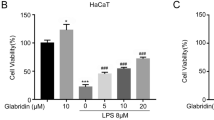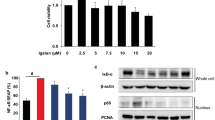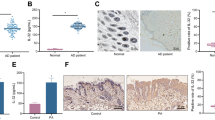Abstract
Objective
Atopic dermatitis (AD) is an inflammatory skin disease. Naringenin (Nar) possesses an anti-inflammatory property. This paper attempts to discuss the functional mechanism of Nar in AD mice through the Janus kinase 2 (JAK2)/signal transducer and activation of transcription 3 (STAT3) pathway.
Methods
Mouse models of DNFB-induced AD were established and treated with Nar, followed by intraperitoneal injection with the JAK2/STAT3 pathway activator Coumermycin A1. Dermatitis severity was scored and the thickness of right ear was measured. The pathological changes in dorsal skin tissues were observed by HE staining. The number of infiltrated mast cells and eosinophilic granulocytes was counted by TB staining. The serum IgE level and levels of TNF-α, IL-6, IFN-γ, IL-12, and IL-5 in dorsal skin tissues were measured by ELISA. The levels of p-JAK2, JAK2, p-STAT3, and STAT3 were determined by Western blot.
Results
Nar decreased dermatitis scores and right ear thickness, alleviated skin lesions, and reduced the number of infiltrated mast cells and eosinophilic granulocytes in AD mice. The serum IgE level and levels of TNF-α, IL-6, IFN-γ, IL-12, and IL-5 in dorsal skin tissues of AD mice were diminished after Nar treatment in a dose-dependent manner. Nar inhibited the activation of the JAK2/STAT3 pathway. The activation of the JAK2/STAT3 pathway partially nullified the therapeutic function of Nar on AD mice.
Conclusion
Nar protects mice from AD by inhibiting inflammation and promoting immune responses through the inhibition of the JAK2/STAT3 pathway.




Similar content being viewed by others
Data availability
All data generated or analysed during this study are included in this article. Further enquiries can be directed to the corresponding author.
References
Atanasov AG, Zotchev SB, Dirsch VM, Sciences INP, Supuran T, C. T (2021) Natural products in drug discovery: advances and opportunities. Nat Rev Drug Discov 20:200–216. https://doi.org/10.1038/s41573-020-00114-z
Bieber T (2010) Atopic dermatitis. Ann Dermatol 22:125–137. https://doi.org/10.5021/ad.2010.22.2.125
Chao L, Li Z, Zhou J, Chen W, Li Y, Lv W, Guo A, Qu Q, Guo S (2020) Front Pharmacol 11:814. https://doi.org/10.3389/fphar.2020.00814. Shen-Ling-Bai-Zhu-San Improves Dextran Sodium Sulfate-Induced Colitis by Inhibiting Caspase-1/Caspase-11-Mediated Pyroptosis
Dong L, Cao TQ, Liu Z, Tuan NQ, Kim YC, Sohn JH, Yim JH, Lee DS, Oh H (2022) Anti-Inflammatory Effects Exerted by 14-Methoxyalternate C from Antarctic Fungal Strain Pleosporales sp. SF-7343 via the Regulation of NF-kappaB and JAK2/STAT3 in HaCaT Human Keratinocytes. Int J Mol Sci 23. https://doi.org/10.3390/ijms232314642
Duan B, Li Y, Geng H, Ma A, Yang X (2021) Naringenin prevents pregnancy-induced hypertension via suppression of JAK/STAT3 signalling pathway in mice. Int J Clin Pract 75:e14509. https://doi.org/10.1111/ijcp.14509
Edslev SM, Agner T, Andersen PS (2020) Skin microbiome in atopic dermatitis. Acta Derm Venereol 100:adv00164. https://doi.org/10.2340/00015555-3514
Fishbein AB, Silverberg JI, Wilson EJ, Ong PY (2020) Update on atopic dermatitis: diagnosis, Severity Assessment, and treatment selection. J Allergy Clin Immunol Pract 8:91–101. https://doi.org/10.1016/j.jaip.2019.06.044
Gao C, Liu C, Chen Y, Wang Q, Hao Z (2021) Protective effects of natural products against drug-induced nephrotoxicity: a review in recent years. Food Chem Toxicol 153:112255. https://doi.org/10.1016/j.fct.2021.112255
Gong L, Manaenko A, Fan R, Huang L, Enkhjargal B, McBride D, Ding Y, Tang J, Xiao X, Zhang JH (2018) Osteopontin attenuates inflammation via JAK2/STAT1 pathway in hyperglycemic rats after intracerebral hemorrhage. Neuropharmacology 138:160–169. https://doi.org/10.1016/j.neuropharm.2018.06.009
Howell MD, Kuo FI, Smith PA (2019) Targeting the Janus kinase family in autoimmune skin Diseases. Front Immunol 10:2342. https://doi.org/10.3389/fimmu.2019.02342
Inokuchi-Sakata S, Ishiuji Y, Katsuta M, Kharma B, Yasuda KI, Tominaga M, Takamori K, Nobeyama Y, Asahina A (2021) Role of Eosinophil relative Count and Neutrophil-to-lymphocyte ratio in the Assessment of Severity of atopic dermatitis. Acta Derm Venereol 101:adv00491. https://doi.org/10.2340/00015555-3838
Jin W, Huang W, Chen L, Jin M, Wang Q, Gao Z, Jin Z (2018) Topical application of JAK1/JAK2 inhibitor momelotinib exhibits significant anti-inflammatory responses in DNCB-Induced atopic dermatitis model mice. Int J Mol Sci 19. https://doi.org/10.3390/ijms19123973
Karuppagounder V, Arumugam S, Thandavarayan RA, Sreedhar R, Giridharan VV, Pitchaimani V, Afrin R, Harima M, Krishnamurthy P, Suzuki K, Nakamura M, Ueno K, Watanabe K (2016) Naringenin ameliorates skin inflammation and accelerates phenotypic reprogramming from M1 to M2 macrophage polarization in atopic dermatitis NC/Nga mouse model. Exp Dermatol 25:404–407. https://doi.org/10.1111/exd.12962
Kaur G, Chauhan K, Kaur S (2018) Immunotherapeutic potential of Codonopsis clematidea and naringenin against visceral leishmaniasis. Biomed Pharmacother 108:1048–1061. https://doi.org/10.1016/j.biopha.2018.09.104
Kim TH, Kim GD, Ahn HJ, Cho JJ, Park YS, Park CS (2013) The inhibitory effect of naringenin on atopic dermatitis induced by DNFB in NC/Nga mice. Life Sci 93:516–524. https://doi.org/10.1016/j.lfs.2013.07.027
Langan SM, Irvine AD, Weidinger S (2020) Atopic dermatitis. Lancet 396:345–360. https://doi.org/10.1016/S0140-6736(20)31286-1
Lee H, Ryu WI, Kim HJ, Bae HC, Ryu HJ, Shin JJ, Song KH, Kim TW, Son SW (2016) TSLP down-regulates S100A7 and ss-defensin 2 Via the JAK2/STAT3-Dependent mechanism. J Invest Dermatol 136:2427–2435. https://doi.org/10.1016/j.jid.2016.07.027
Lee DE, Clark AK, Tran KA, Shi VY (2018) New and emerging targeted systemic therapies: a new era for atopic dermatitis. J Dermatolog Treat 29:364–374. https://doi.org/10.1080/09546634.2017.1373736
Li H, Zhang Z, Zhang H, Guo Y, Yao Z (2021) Update on the pathogenesis and therapy of atopic dermatitis. Clin Rev Allergy Immunol 61:324–338. https://doi.org/10.1007/s12016-021-08880-3
Liang J, Halipu Y, Hu F, Yakeya B, Chen W, Zhang H, Kang X (2017) Naringenin protects keratinocytes from oxidative stress injury via inhibition of the NOD2-mediated NF-kappaB pathway in pemphigus vulgaris. Biomed Pharmacother 92:796–801. https://doi.org/10.1016/j.biopha.2017.05.112
Motallebi M, Bhia M, Rajani HF, Bhia I, Tabarraei H, Mohammadkhani N, Pereira-Silva M, Kasaii MS, Nouri-Majd S, Mueller AL, Veiga FJB, Paiva-Santos AC, Shakibaei M (2022) Naringenin: a potential flavonoid phytochemical for cancer therapy. Life Sci 305:120752. https://doi.org/10.1016/j.lfs.2022.120752
Nagula RL, Wairkar S (2020) Cellulose microsponges based gel of naringenin for atopic dermatitis: design, optimization, in vitro and in vivo investigation. Int J Biol Macromol 164:717–725. https://doi.org/10.1016/j.ijbiomac.2020.07.168
Nakashima C, Yanagihara S, Otsuka A (2022) Innovation in the treatment of atopic dermatitis: emerging topical and oral Janus kinase inhibitors. Allergol Int 71:40–46. https://doi.org/10.1016/j.alit.2021.10.004
Noori S, Rezaei Tavirani M, Deravi N, Rabbani M, Zarghi MI, A (2020) Naringenin enhances the Anti-Cancer Effect of Cyclophosphamide against MDA-MB-231 breast Cancer cells Via targeting the STAT3 signaling pathway. Iran J Pharm Res 19:122–133. https://doi.org/10.22037/ijpr.2020.113103.14112
Noori S, Nourbakhsh M, Imani H, Deravi N, Salehi N, Abdolvahabi Z (2022) Naringenin and cryptotanshinone shift the immune response towards Th1 and modulate T regulatory cells via JAK2/STAT3 pathway in breast cancer. BMC Complement Med Ther 22:145. https://doi.org/10.1186/s12906-022-03625-x
Puar N, Chovatiya R, Paller AS (2021) New treatments in atopic dermatitis. Ann Allergy Asthma Immunol 126:21–31. https://doi.org/10.1016/j.anai.2020.08.016
Quah Y, Lee SJ, Lee EB, Birhanu BT, Ali MS, Abbas MA, Boby N, Im ZE, Park SC (2020) Cornus officinalis Ethanolic Extract with Potential Anti-Allergic, Anti-Inflammatory, and Antioxidant Activities. Nutrients 12. https://doi.org/10.3390/nu12113317
Rauf A, Shariati MA, Imran M, Bashir K, Khan SA, Mitra S, Emran TB, Badalova K, Uddin MS, Mubarak MS, Aljohani ASM, Alhumaydhi FA, Derkho M, Korpayev S, Zengin G (2022) Comprehensive review on naringenin and naringin polyphenols as a potent anticancer agent. Environ Sci Pollut Res Int 29:31025–31041. https://doi.org/10.1007/s11356-022-18754-6
Reuter J, Merfort I, Schempp CM (2010) Botanicals in dermatology: an evidence-based review. Am J Clin Dermatol 11:247–267. https://doi.org/10.2165/11533220-000000000-00000
Siiskonen H, Harvima I (2019) Mast cells and sensory nerves contribute to neurogenic inflammation and Pruritus in Chronic skin inflammation. Front Cell Neurosci 13:422. https://doi.org/10.3389/fncel.2019.00422
Silverberg JI (2019) Comorbidities and the impact of atopic dermatitis. Ann Allergy Asthma Immunol 123:144–151. https://doi.org/10.1016/j.anai.2019.04.020
Spergel JM, Paller AS (2003) Atopic dermatitis and the atopic march. J Allergy Clin Immunol 112. https://doi.org/10.1016/j.jaci.2003.09.033. S118-127
Sroka-Tomaszewska J, Trzeciak M (2021) Molecular Mechanisms of atopic Dermatitis Pathogenesis. Int J Mol Sci 22. https://doi.org/10.3390/ijms22084130
Suarez-Farinas M, Dhingra N, Gittler J, Shemer A, Cardinale I, de Guzman Strong C, Krueger JG, Guttman-Yassky E (2013) Intrinsic atopic dermatitis shows similar TH2 and higher TH17 immune activation compared with extrinsic atopic dermatitis. J Allergy Clin Immunol 132:361–370. https://doi.org/10.1016/j.jaci.2013.04.046
Tamagawa-Mineoka R, Katoh N (2020) Atopic dermatitis: identification and management of complicating factors. Int J Mol Sci 21. https://doi.org/10.3390/ijms21082671
Tsiogka A, Kyriazopoulou M, Kontochristopoulos G, Nicolaidou E, Stratigos A, Rigopoulos D, Gregoriou S (2022) The JAK/STAT pathway and its selective inhibition in the treatment of atopic dermatitis: a systematic review. J Clin Med 11. https://doi.org/10.3390/jcm11154431
Wang Q, Ou Y, Hu G, Wen C, Yue S, Chen C, Xu L, Xie J, Dai H, Xiao H, Zhang Y, Qi R (2020) Naringenin attenuates non-alcoholic fatty liver disease by down-regulating the NLRP3/NF-kappaB pathway in mice. Br J Pharmacol 177:1806–1821. https://doi.org/10.1111/bph.14938
Wu S, Pang Y, He Y, Zhang X, Peng L, Guo J, Zeng J (2021) A comprehensive review of natural products against atopic dermatitis: flavonoids, alkaloids, terpenes, glycosides and other compounds. Biomed Pharmacother 140:111741. https://doi.org/10.1016/j.biopha.2021.111741
Xiong X, Huang C, Wang F, Dong J, Zhang D, Jiang J, Feng Y, Wu B, Xie T, Cheng L (2021) Qingxue jiedu formulation ameliorated DNFB-induced atopic dermatitis by inhibiting STAT3/MAPK/NF-kappaB signaling pathways. J Ethnopharmacol 270:113773. https://doi.org/10.1016/j.jep.2020.113773
Yamamoto M, Haruna T, Yasui K, Takahashi H, Iduhara M, Takaki S, Deguchi M, Arimura A (2007) A novel atopic dermatitis model induced by topical application with dermatophagoides farinae extract in NC/Nga mice. Allergol Int 56:139–148. https://doi.org/10.2332/allergolint.O-06-458
Zaim O, Doganlar O, Banu Doganlar Z, Ozcan H, Zreigh MM, Kurtdere K (2022) Novel synthesis naringenin-benzyl piperazine derivatives prevent glioblastoma invasion by inhibiting the hypoxia-induced IL6/JAK2/STAT3 axis and activating caspase-dependent apoptosis. Bioorg Chem 129:106209. https://doi.org/10.1016/j.bioorg.2022.106209
Zeng H, Zhao B, Zhang D, Rui X, Hou X, Chen X, Zhang B, Yuan Y, Deng H, Ge G (2022) Viola yedoensis Makino formula alleviates DNCB-induced atopic dermatitis by activating JAK2/STAT3 signaling pathway and promoting M2 macrophages polarization. Phytomedicine 103:154228. https://doi.org/10.1016/j.phymed.2022.154228
Zu Y, Chen XF, Li Q, Zhang ST (2021) CYT387, a novel JAK2 inhibitor, suppresses IL-13-Induced epidermal barrier Dysfunction Via miR-143 targeting IL-13Ralpha1 and STAT3. Biochem Genet 59:531–546. https://doi.org/10.1007/s10528-020-10003-0
Funding
Not applicable.
Author information
Authors and Affiliations
Contributions
LT and MW contributed to the study concepts, study design; YW, LT contributed to the literature research; MW, LT, YW contributed to the experimental studies and data acquisition; LT, MW, WL, YY contributed to the data analysis and statistical analysis; LT, MW contributed to the manuscript preparation and YY contributed to the manuscript editing and review; All authors read and approved the final manuscript.
Corresponding author
Ethics declarations
Ethics statement
The animal-related experimental procedures were in line with the protocols approved by the Animal Ethics Committee of First Affiliated Hospital of Baotou Medical College of Inner Mongolia University of Science and Technology. The number of drop-out animals was zero until the day of final experiments.
Competing interests
The authors report no conflicts of interest.
Additional information
Publisher’s Note
Springer Nature remains neutral with regard to jurisdictional claims in published maps and institutional affiliations.
Limin Tian and Mengjie Wang contributed equally to this work.
Rights and permissions
Springer Nature or its licensor (e.g. a society or other partner) holds exclusive rights to this article under a publishing agreement with the author(s) or other rightsholder(s); author self-archiving of the accepted manuscript version of this article is solely governed by the terms of such publishing agreement and applicable law.
About this article
Cite this article
Tian, L., Wang, M., Wang, Y. et al. Naringenin ameliorates atopic dermatitis by inhibiting inflammation and enhancing immunity through the JAK2/STAT3 pathway. Genes Genom 46, 333–340 (2024). https://doi.org/10.1007/s13258-023-01457-8
Received:
Accepted:
Published:
Issue Date:
DOI: https://doi.org/10.1007/s13258-023-01457-8




